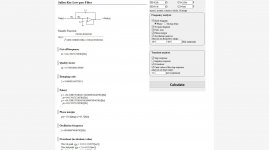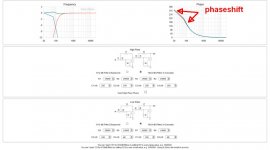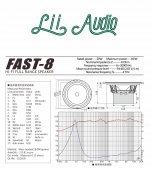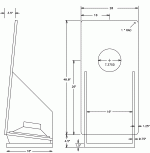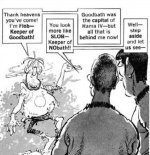to Peppeninno #296
Not so easy to get 80-90 hz in the low-pass with a 12dB slope
without
-big phaseshift (150deg.)
-Q-factor around 0.7
-dampingfactor in simulation: 0.68
I simulated with 150nF and 68nF / 20kOhm and 14kOhm.
😕
I think you have to try and listen
Greets
Dirk
Not so easy to get 80-90 hz in the low-pass with a 12dB slope
without
-big phaseshift (150deg.)
-Q-factor around 0.7
-dampingfactor in simulation: 0.68
I simulated with 150nF and 68nF / 20kOhm and 14kOhm.
😕
I think you have to try and listen
Greets
Dirk
Attachments
But you are playing with the electric simulation. You need to do it with the acoustic responses in the end. With subwoofers it is also a matter of where you place them in the room. In the end it will rarely be the strict Butterworth, Linkwitz-Riley or whatever. That is also the good point with this crossover. What does the frequency response look like for the bass and the rest?
to RogerGustavsson #303
I fully agree with you. These are only simulations.
Peppennino has to try and listen. Moving the subwoofer closer / away from listening position, perhaps reverse polarity at output of amp,....
Loudspeakers have that different behaviour.
Testing, adjusting and listening is part of the fun! 😀
Greets
Dirk
I fully agree with you. These are only simulations.
Peppennino has to try and listen. Moving the subwoofer closer / away from listening position, perhaps reverse polarity at output of amp,....
Loudspeakers have that different behaviour.
Testing, adjusting and listening is part of the fun! 😀
Greets
Dirk
But you are playing with the electric simulation. You need to do it with the acoustic responses in the end. With subwoofers it is also a matter of where you place them in the room. In the end it will rarely be the strict Butterworth, Linkwitz-Riley or whatever. That is also the good point with this crossover. What does the frequency response look like for the bass and the rest?
As I wrote, it's a Pass' SLOB, not a separate sub
Attachments
I found that page earlier but it does not provide much information. The shown frequency response seems to be for a driver in a test baffle (use to be a closed box). You mentioned a open baffle and an Eminent bass driver.
Not so easy to get 80-90 hz in the low-pass with a 12dB slope
Firstwatt B5 had only 12 and 6 dB slopes.
I found that page earlier but it does not provide much information. The shown frequency response seems to be for a driver in a test baffle (use to be a closed box). You mentioned a open baffle and an Eminent bass driver.
Eminence Beta 15, but we can also try Alpha 15 (higher qts)
Clearly the Eminence is in the SLOB, but is it 2 units - or a single? ripole?
And in that case, the Eminence already have a high Q, actually much higher than needed for SLOB, Peppennino are you running it with a coil in series as well - which is often part of the recipe?
Depending on the slot size you will have a quite big resonance peak - most likely somewhere between 200-350Hz.
It can be somewhat reduced by a non symmetric slot wall, but even so I have not been able to get rid of the peak. And you very likely will need more than 12dB to get it properly squared away 😉
Anyway - as Roger implies it's far from trivial - and SLOB does not make it easier. I would not spend too much time on fine-tuning the simulation before doing the first measurements - and eventually feeding these back into the calculations. There is quite a tolerance on most units which can shift results quite a bit.
I use Faital 15PR400's in SLOB, the datasheet: Fs = 35Hz, actual value 32(->28Hz run in) in SLOB it's down to 18 (->16Hz run in). And these are proper high quality pro units!
And in that case, the Eminence already have a high Q, actually much higher than needed for SLOB, Peppennino are you running it with a coil in series as well - which is often part of the recipe?
Depending on the slot size you will have a quite big resonance peak - most likely somewhere between 200-350Hz.
It can be somewhat reduced by a non symmetric slot wall, but even so I have not been able to get rid of the peak. And you very likely will need more than 12dB to get it properly squared away 😉
Anyway - as Roger implies it's far from trivial - and SLOB does not make it easier. I would not spend too much time on fine-tuning the simulation before doing the first measurements - and eventually feeding these back into the calculations. There is quite a tolerance on most units which can shift results quite a bit.
I use Faital 15PR400's in SLOB, the datasheet: Fs = 35Hz, actual value 32(->28Hz run in) in SLOB it's down to 18 (->16Hz run in). And these are proper high quality pro units!
Last edited:
regarding Eminence Alpha 15
once I asked Pa about these ......... he said - I like mine speakers having some magnet
go figure 🙂
once I asked Pa about these ......... he said - I like mine speakers having some magnet
go figure 🙂
regarding Eminence Alpha 15
once I asked Pa about these ......... he said - I like mine speakers having some magnet
go figure 🙂
OK, we'll go for Beta 😀
Slob?Yes, Nelson"s SLOB
Attachments
Firstwatt B5 had only 12 and 6 dB slopes.
It was designed around the OBs and SLOBs with FR mid/top. These were
the slopes that worked consistently with a wide range of drivers -
yours most likely.

- Home
- Amplifiers
- Pass Labs
- DIY biamp 6-24 crossover
